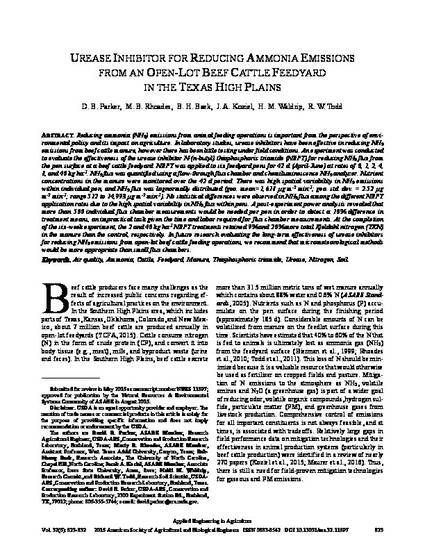
Reducing ammonia (NH3) emissions from animal feeding operations is important from the perspective of environmental policy and its impact on agriculture. In laboratory studies, urease inhibitors have been effective in reducing NH3 emissions from beef cattle manure, however there has been little testing under field conditions. An experiment was conducted to evaluate the effectiveness of the urease inhibitor N-(n-butyl) thiophosphoric triamide (NBPT) for reducing NH3 flux from the pen surface at a beef cattle feedyard. NBPT was applied to six feedyard pens for 42 d (April-June) at rates of 0, 1, 2, 4, 8, and 40 kg ha-1. NH3 flux was quantified using a flow-through flux chamber and chemiluminescence NH3 analyzer. Nutrient concentrations in the manure were monitored over the 42 d period. There was high spatial variability in NH3 emissions within individual pen, and NH3 flux was lognormally distributed (geo. mean=1,618 μg m&-2 min&-1; geo. std. dev. = 2.52 μg m&-2 min&-1; range 512 to 14,993 μg m&-2 min&-1). No statistical differences were observed in NH3 flux among the different NBPT application rates due to the high spatial variability in NH3 flux within pens. A post&-experiment power analysis revealed that more than 500 individual flux chamber measurements would be needed per pen in order to detect a 10% difference in treatment means, an impractical task given the time and labor required for flux chamber measurements. At the completion of the six-week experiment, the 2 and 40 kg ha-1 NBPT treatments retained 9% and 20% more total Kjeldahl nitrogen (TKN) in the manure than the control, respectively. In future research evaluating the long-term effectiveness of urease inhibitors for reducing NH3 emissions from open-lot beef cattle feeding operations, we recommend that micrometeorological methods would be more appropriate than small flux .
Available at: http://works.bepress.com/jacek_koziel/116/

This article is from Applied Engineering in Agriculture. 32(6): 823-832. (doi: 10.13031/aea.32.11897).